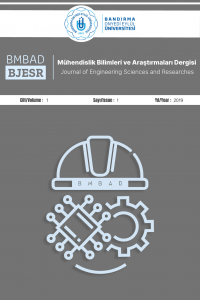Evrişimli Sinir Ağlarında Transfer Öğrenmesi ile GAN tarafından Üretilen Sahte Görüntü Tespiti
Sentetik Görüntü, Çekişmeli Üretken Ağlar, Evrişimli Sinir Ağları
GAN-Generated Fake Image Detection with Transfer Learning in Convolutional Neural Networks
___
- I. Goodfellow vd. “Generative adversarial networks”, Commun. ACM, vol. 63, no. 11, pp. 139–144, 2020.
- S. Motamed, P. Rogalla, ve F. Khalvati “Data augmentation using Generative Adversarial Networks (GANs) for GAN-based detection of Pneumonia and COVID-19 in chest X-ray images”, Informatics Med. Unlocked, vol. 27, p. 100779, 2021.
- N. Sharma, R. Sharma, ve N. Jindal “Comparative analysis of CycleGAN and AttentionGAN on face aging application”, Sādhanā, vol. 47, no. 1, p. 33, 2022.
- R. Huang, L. Ma, J. He, ve X. Chu “T-GAN: A deep learning framework for prediction of temporal complex networks with adaptive graph convolution and attention mechanism”, Displays, vol. 68, p. 102023, 2021.
- A. Creswell, T. White, V. Dumoulin, K. Arulkumaran, B. Sengupta, ve A.A. Bharath “Generative Adversarial Networks: An Overview”, IEEE Signal Processing Magazine, vol. 35, no. 1. pp. 53–65, 2018.
- S. Stoll, N. C. Camgoz, S. Hadfield, ve R. Bowden “Text2Sign: Towards Sign Language Production Using Neural Machine Translation and Generative Adversarial Networks”, Int. J. Comput. Vis., vol. 128, no. 4, pp. 891–908, 2020.
- K. Nazeri, E. Ng, ve M. Ebrahimi “Image colorization using generative adversarial networks”, içinde Lecture Notes in Computer Science (including subseries Lecture Notes in Artificial Intelligence and Lecture Notes in Bioinformatics), LNCS, vol. 10945 pp. 85–94, 2018.
- C. Fabbri, M.J. Islam, ve J. Sattar “Enhancing Underwater Imagery Using Generative Adversarial Networks”, içinde Proceedings - IEEE International Conference on Robotics and Automation, pp. 7159–7165, 2018.
- G. Antipov, M. Baccouche, ve J.L. Dugelay “Face aging with conditional generative adversarial networks”, içinde Proceedings - International Conference on Image Processing, ICIP, pp. 2089–2093, 2018.
- F. Marra, D. Gragnaniello, D. Cozzolino, ve L. Verdoliva “Detection of GAN-Generated Fake Images over Social Networks”, IEEE 1st Conference on Multimedia Information Processing and Retrieval, MIPR, pp. 384–389.
- D. Cozzolino, G. Poggi, ve L. Verdoliva “Recasting residual-based local descriptors as convolutional neural networks: An application to image forgery detection”, Proceedings of the 2017 ACM Workshop on Information Hiding and Multimedia Security, pp. 159–164, 2017.
- B. Bayar ve M.C. Stamm “A deep learning approach to universal image manipulation detection using a new convolutional layer”, Proceedings of the 2016 ACM Information Hiding and Multimedia Security Workshop, pp. 5–10, 2016.
- L. Nataraj vd. “Detecting GAN generated Fake Images using Co-occurrence Matrices”, Electron. Imaging, vol. 31, no. 5, pp. 532-1-532–7, 2019.
- S. McCloskey ve M. Albright “Detecting GAN-Generated Imagery Using Saturation Cues”, International Conference on Image Processing, ICIP, pp. 4584–4588.
- Y. LeCun ve Y. Bengio “Convolutional networks for images, speech, and time series”, Handb. brain theory neural networks, vol. 3361, pp. 255–258, 1995, [Çevrimiçi]. Available at: http://citeseerx.ist.psu.edu/viewdoc/download?doi=10.1.1.32.9297&rep=rep1&type=pdf.
- T. Rahman vd. “Transfer Learning with Deep Convolutional Neural Network (CNN) for Pneumonia Detection Using Chest X-ray”, Appl. Sci., vol. 10, no. 9, p. 3233, 2020.
- S. Raghu, N. Sriraam, Y. Temel, S.V. Rao, ve P.L. Kubben “EEG based multi-class seizure type classification using convolutional neural network and transfer learning”, Neural Netw., vol. 124, pp. 202–212, 2020.
- ISSN: 2687-4415
- Yayın Aralığı: Yılda 2 Sayı
- Başlangıç: 2019
- Yayıncı: Bandırma Onyedi Eylül Üniversitesi
Yalçın IŞIK, Mehmet KEHYA, Ahmet KAYABAŞI
Tag: Blokzincirinden Esinlenilen Veri Yapısı
Alpay DORUK, Savaş TAKAN, Fatih SOYGAZİ, Zeynep DEMİRTAŞ, Elnur AKKURT
Ali Berk YALINKILIÇ, Saffet VATANSEVER
Nursel ÖKSÜZ, Özge KABCUK, Mehmet SAVAŞ, İsmail KOÇAK
A case study: Understanding The Nature of Memories Architectures in FPGAs to Built-up Bi-CAM
Halit ÖZTEKİN, İhsan PEHLİVAN, Abdelkader LAZZEM
Endüstriyel Kontrol Sistemlerinde Yenilikçi Anomali Tespit Sistemlerinin İncelenmesi
Elektronik Olarak Ayarlanabilen FDCCII Tabanlı Yeni Memkapasitör Emülatör Devresi
Muhammet Oğuz KORKMAZ, Abdullah YESİL
Hülya DOĞAN, Ramazan Özgür DOĞAN
Yapay Zekâ Yaklaşımlarını Kullanarak Retinopati Hastalığının Tespiti
